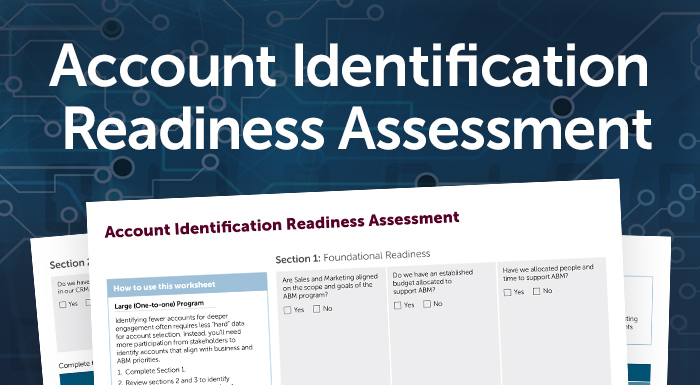Your Questions About ABM Answered

Share this story
During a recent webinar on how to operationalize account-based marketing, our very engaged audience asked so many excellent questions about ABM we wanted to share them here, with the goal of helping you realistically plan or adapt your own ABM strategies.
1. We are new to ABM; what types of companies are using ABM successfully?
It’s less about the type of company you are and more about whether ABM makes sense for your business — and is something that you can actually do. If you’d benefit from aligning your sales and marketing against a list of specific companies rather than a profile of companies, then it could be an effective tactic for you.
For example, if your products / solutions are “considered purchase” (complex, longer cycle, multi-constituent, more expensive) rather than transactional, you’ll likely do better with ABM.
2. Which team is typically responsible for prioritizing accounts: sales or marketing?
This will depend on your approach and your organization. If you are using a process or technology to dynamically prioritize accounts, this will typically fall to marketing. However, sales must be aligned on the methodology. If you are using a static prioritization, it could be either or both.
3. Can you elaborate more on what a “buying center” is? How can sales identify and tag appropriately in a CRM?
When we say “buying center,” we are talking about a group of people within an organization who typically make purchase decisions together, regardless of whether they are in the same physical location. Most CRMs allow you to track these people as a group within an “Opportunity”; however, that record is lost once the Opportunity is closed. This is why we sometimes add a custom object into CRM systems to store this information, as it is an important element in understanding how an account makes purchases.
4. Can you provide an example of an “account engagement score”?
An account engagement score is a number on a relative scale that represents the collective engagement of contacts within an account. Most CRMs and marketing automation tools are not created to present this view of activity across an account. Different ABM tools have different ways of calculating their version of an engagement score at the account level. For example, Engagio’s score is based on the concept of “engagement minutes,” which assigns the amount of time people might engage with different assets, then rolls up all that time by contacts within an organization into a total engagement score for the account. If you want the account engagement score to be part of your metrics mix, it is important to understand how the different tools calculate it and pick the tool that is the most meaningful to your business.
5. Do you have any economical suggestions for managing offline data and IP targeting?
If you are already using and paying for a marketing automation platform (MAP), it’s worth it to speak to your rep about what type of IP targeting tools they offer. Marketo, for example, offers reverse IP identification at a fraction of the cost of many of the tools out there right now.
6. How do you assign revenue opportunities that are unique to ABM-generated accounts? Can you show an ABM strategy drives real revenue compared to non-ABM?
The short answer is to “wire up” an Accounts view of your pipeline (leads through close) in your CRM so you can monitor activities at the account level. This is not how CRMs natively report, so it will require someone who knows what they are doing.
7. We are using Salesforce.com as our CRM — how well will it work to support our efforts?
The short answer is that it works well, but you’ll have to make some adjustments. One tip is to start adjusting your data structure so that Accounts = Locations and Master Accounts = Accounts. This restructuring connects multiple locations to the Master Accounts and will allow you to have an accounts-based view of the data.
You’ll also need to do some work to produce reports that provide an accounts-based pipeline view instead of a leads / opportunities view. You’ll need to use a third-party tool or find someone to assist you with making these adjustments, as this is not an “out of the box” feature.
8. We have a lot of opinions about what accounts should be on our ABM list. How do we decide which ones to target?
The answer is really simple — it all should stem from your data and account insights! At the very minimum, internal opinions should be validated against a few years of sales information to create a firmographic profile of your most profitable accounts. The profile should then line up with the companies on your named accounts list. You should also look for external sources to verify, such as predictive profiling, to ensure your teams’ intuition is on track. Taking these steps should not add a lot of time to your process; it’s really just a matter of weeks, or a month at the most.
9. We’re going after a short list of accounts with very big opportunities. What should we do differently?
A small list of named accounts — say, 10 accounts that are representative of multi-million dollar contracts — provides a great opportunity for one-to-one ABM strategies. Consider targeting each account’s corporate headquarters with surround marketing, using out-of-home buys, geo-targeted direct marketing, and a dedicated pursuit budget to create really specific sales materials and videos. In this case, automation and scale matter a lot less. Targeted, insight-driven, custom care and feeding to these key accounts matter a lot more!
10. How should we holistically plan for ABM from the get-go, including third-party technology recommendations?
A great starting point is to download our ABM playbook and share it with your team. It provides a thorough overview of the seven areas you need to focus on to execute ABM successfully from the “crawl,” “walk” and “run” perspectives.

